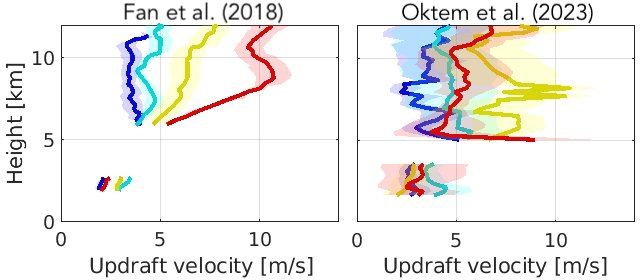Öktem, Romps, and Varble, No warm-phase invigoration of convection detected during GoAmazon, JAS, 2023
Paper
Description
It is well-known that air pollution affects clouds in some ways, most notably by increasing their brightness, but it is debated whether or not air pollution makes storm clouds more energetic. A long-standing hypothesis is that air pollution invigorates storm clouds in the sense of increasing their updraft speeds. One of the proposals for how this would work is called "warm-phase invigoration." In this mechanism, air pollution would make warm-phase updrafts (i.e., ascending liquid clouds in the lower troposphere) more buoyant and, therefore, faster.
Fan et al. (2018) offered evidence in favor of warm-phase invigoration using observations from the GoAmazon campaign. Conducted in the Amazon rainforest in 2014, the GoAmazon campaign collected, among other things, the amount of air pollution in the air and the speed of cloud updrafts. Fan et al. used subjective criteria to sort updraft speeds into four categories of air pollution, from low to high, and showed that the updraft speeds increased accordingly.
Here, we reexamine those GoAmazon observations using objective criteria. Using the same data, we find no evidence of warm-phase invigoration. To the contrary, the data appear to rule out any substantial warm-phase invigoration.
When analyzed objectively, the data hint at a correlation between boundary-layer aerosol concentration and moist-convective reflectivity in the upper troposphere, but the correlation is not statistically significant. Even if such a correlation exists, it is very likely caused by something other than warm-phase invigoration, e.g., a different invigoration mechanism, or a direct effect of aerosols on microphysics (without any invigoration), or a non-causal correlation that aerosols and updrafts share with the synoptic or mesoscale meteorology.
(left) The average updraft speeds in air with four different ranges of aerosol concentrations (increasing from blue to red) as calculated by Fan et al. (2018) using subjective criteria. (right) Same, but as calculated by Öktem et al. (2023) using objective criteria.
